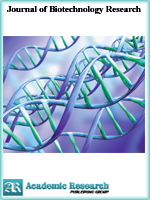Journal of Biotechnology Research
Online ISSN: 2413-3256
Print ISSN: 2413-8878
Print ISSN: 2413-8878
Quarterly Published (4 Issues Per Year)

Archives
Volume 5 Number 10 October 2019
Wheat Substitutes for Gluten-Free Pasta: An Integrative Review
Authors: Andréa Alves Seixas Lima ; Deborah Murowaniecki Otero ; Camila Duarte Ferreira-Ribeiro ; Márcia Regina da Silva
Pages: 100-106
DOI: doi.org/10.32861/jbr.510.100.106
Abstract
Pasta are present in the basic basket of the Brazilian population and constitute one of the main substitutes for rice. The ingredient traditionally used in the preparation of these pastas is wheat flour, in which gluten is present. Gluten is proven to be related to some diseases that have been increasingly common in our population. The aim of this work was conduct an integrative review on the main wheat substitutes in the preparation of gluten-free pasta. For this, the following question arose: what are the current substitutes for wheat in the preparation of gluten-free pasta? The survey was conducted from January to June 2019, in the main electronic databases and online platforms. 84 articles were found, and 14 articles were included because they were eligible. Thirteen different raw materials were found, used in the preparation of noodles, rice being the most prevalent in substitution to wheat. The range of ingredients that can be used for wheat substitution is evident, but it is expected that further studies will be carried out in order to be able to produce pasta with characteristics closer to those offered by gluten and that are sensorial accepted by the population.
Characterization of Protein-Lipid Interactions in Biosystems Processes
Authors: Dr. Chrysanthus Chukwuma Sr
Pages: 93-99
DOI: doi.org/10.32861/jbr.510.93.99
Abstract
Lipids correlate with membrane characteristics and functionalities as macromolecular constituentts in all cellular processes. Numerous aspects of lipid modulation of protein activity and structure are not completely understood and, thus a holistic systematic investigation activities will be pertinent. Protein-lipid interactions are the resultant impacts of membrane proteins on lipid physical states or vice versa. Encompassing research needs to be associated with strategies to elucidate whether proteins contain binding sites which are lipid specific, and that the protein-lipid complexes are ostensibly long-lived, on the time order necessary for the turnover of a normal enzyme. Biological membranes have since been determined as essential ingredients in an expansive array of cellular processes, such as photosynthesis, cell defence, signaling transduction, communication and motility. Therefore, they constitute multiple targets in both basic and applied research. Protein-lipid interactions are becoming increasingly relevant to the morphological characterization of membrane proteins as related to their functionalities. Excepting for simplified models, certain protein-lipid interactions specifically constitute remarkable challenges which require optimum experimental paradigm and design.



